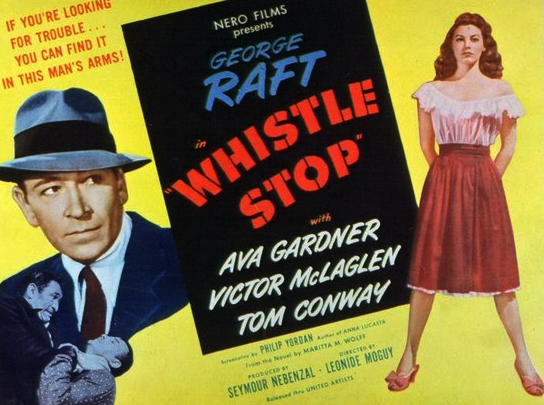Whistle Stop

Main Credits
Director: Léonide Moguy. Screenplay: Philip Yordan based on the novel by Maritta M. Wolff. Producer: Seymour Nebenzal (Nero Films). Director of Photography: Russell Metty. Music: Dimitri Tiomkin. Art Director: Rudi Field. Editor: Gregg Tallas. Cast: George Raft (Kenny Veech), Ava Gardner (Mary), Victor McLaglen (Gitlo), Tom Conway (Lew Lentz), Jorja Curtright (Fran), Jane Nigh (Josie Veech), Florence Bates (Molly Veech), Charles Drake (Ernie), Charles Judels (Sam Veech), Carmel Myers (Estelle), Jimmy Conlin (Al – the Barber), Mack Gray (Bartender). Released: United Artists, January 25, 1946. 85 minutes.
From Film Noir: The Encyclopedia
Plot Summary
After two years in Chicago, Mary returns to Ashbury to get back together with Kenny, a ne’er-do-well. But he is jealous of Lou, a nightclub owner. Piqued at Kenny, she starts seeing Lou. At the town’s annual fair Lou makes a lot of money “from the concessions,” which he takes by train to deposit in Detroit. Kenny and a friend, Gitlo, plan to kill Lou at the station, steal the money and hide his body to make it look like he never came back from Detroit. Kenny and Mary make up. The night of the robbery Mary suspects Kenny is up to no good, and she prevents him from getting to the station. When she discovers he has a gun, she is heartbroken. She goes back to Lou, but it doesn’t work out. She and Kenny try again. Seeking revenge, Lou murders an employee and sends for the cops to frame Kenny and Gitlo. Although Kenny is wounded by the police, he and Gitlo make it to another town. Gitlo comes back to tell Mary where she can find Kenny. He goes after Lou, and they kill each other. Mary knows Kenny is innocent, and she brings him home.
Commentary
Although there are important ways Whistle Stop is bifurcated, it consistently sticks to the social world of the Ashbury working class. The townspeople are shown at a barbershop, pool hall, beer joint, and the fair. The story’s characters and the crimes some of them commit, photographed without the glossiness of an A-picture budget, could be in a pulp magazine. However, the film also tells of love that is lost, unrequited, regained, rejected, and, ultimately, triumphant.
Kenny and Mary’s on-again, off-again passion for each other, which forms the heart of the film, could be in a romantic potboiler. The mix between the two kinds of storylines, hardboiled and melodramatic, follows the film’s source, Whistle Stop, the first novel by 22-year old Maritta M. Wolff. Published in 1941, it was a best seller, titillating both sexes. However, the Hollywood version bowdlerizes the original, in which, for example, Mary is Kenny’s sister and incest is suggested.
As in melodrama, there are other love interests for the principals. Fran, a waitress at Lou’s club, is devoted to Kenny. Lou is a heel that Mary takes up with when Kenny won’t make the changes she wants.
As in hardboiled fiction, a bad influence, Gitlo, has a scheme to get Kenny what he wants — money and Mary.
The melodramatic solution for Fran is accidental death. The hardboiled method for getting rid of Gitlo and Lou is violent death. Indeed, each of them dies the appropriate way.
Meanwhile, Kenny and Mary learn melodrama’s lesson for staying together, which is, as Kenny puts it, “You get what you give.” Mary had urged Kenny to move with her to Chicago, but he refused because he didn’t want to wind up digging ditches. Instead, he stayed in Ashbury and continued “boozing, loafing and playing cards.” After she returns to the town, she repeatedly fails to get him to change. But when she says that she loves him the way he is, he immediately takes a job laying railroad track. The work isn’t too different from ditch-digging, but he is doing it on his own terms.
Kenny must compromise, too. More than once Mary makes the first move to give their relationship another chance. Then she breaks up with him because he treats her commitment as his due, and he won’t give an inch on changing. When he stops trying to have his cake as well as eat it, he gets her for keeps.
Whistle Stop is almost entirely shot at an angle that is slightly upwards, which creates an affirmative viewpoint of the working class characters. Only in a couple of instances is there a point-of-view looking downwards, mainly when Lou faces Mary and later Gitlo seated below him in his office. The mixture of melodrama and hardboiled storylines is replicated in the mise-en-scene. On the one hand, the Veech’s house, especially Mary’s bedroom, is brightly lit. On the other, an impressive noir style is used for the locations associated with crime – the whistle stop, Lou’s office (where he frames Kenny for a murder) and his residence (where he and Gitlo kill each other).